七年级英语下册第八单元备课
- 格式:docx
- 大小:150.26 KB
- 文档页数:66
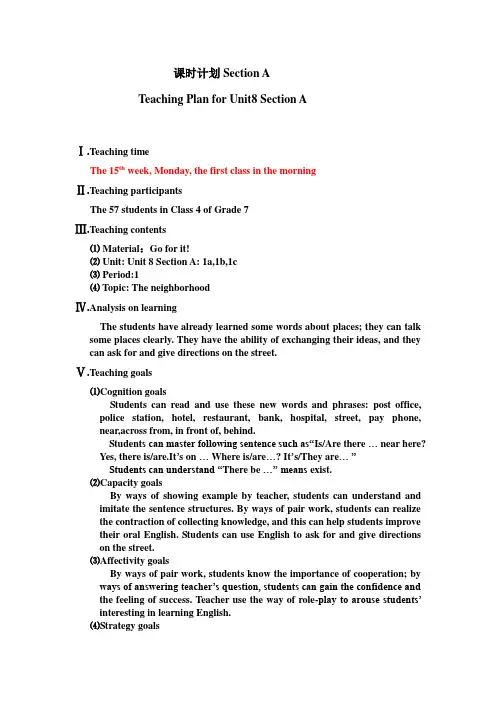
课时计划Section ATeaching Plan for Unit8 Section AⅠ.Teaching timeThe 15th week, Monday, the first class in the morningⅡ.Teaching participantsThe 57 students in Class 4 of Grade 7Ⅲ.Teaching contents⑴ Material:Go for it!⑵ Unit: Unit 8 Section A: 1a,1b,1c⑶ Period:1⑷ Topic: The neighborhoodⅣ.Analysis on learningThe students have already learned some words about places; they can talk some places clearly. They have the ability of exchanging their ideas, and they can ask for and give directions on the street.Ⅴ.Teaching goals⑴Cognition goalsStudents can read and use these new words and phrases: post office, police station, hotel, restaurant, bank, hospital, street, pay phone, near,across from, in front of, behind.Student s can master following sentence such as“Is/Are there … near here?Yes, there is/are.It’s on … Where is/are…? It’s/They are…”Students can understand “There be …” means exist.⑵Capacity goalsBy ways of showing example by teacher, students can understand and imitate the sentence structures. By ways of pair work, students can realize the contraction of collecting knowledge, and this can help students improve their oral English. Students can use English to ask for and give directions on the street.⑶Affectivity goalsBy ways of pair work, students know the importance of cooperation; by ways of answering teacher’s question, students can gain the confidence and the feeling of success. Teacher use the way of role-play to arouse students’ interesting in learning English.⑷Strategy goalsStudents can use context, imitate the dialogue in the context, and transform information by role-playing in English.⑸Cultural goalsStudents know everyone has their own dreams about their future jobs.Students can give their reasonable expiations for their choice about theirdream jobs in English.Students can realize a good plan is a good start tosuccess.Ⅵ.Teaching key points⑴ Teaching important pointsStudents can master the key vocabulary “post office, police station,hotel, restaurant, bank, hospital, street, pay phone, near”, and they canalso master following sentence such as“Is/Are there … near here? Yes,there is/are.It’s on … Where is/are…? It’s/They are…”⑵ Teaching difficultiesStudents can master some basic knowledge about There be structure and understand the grammar point “Prepositions of place”. Students can ask for and give directions on the street clearly.Ⅶ.Teaching methodStudents can ask for and give directions on the street clearly by watching, listening and using context as well as working in pairs.Ⅷ.Teaching aidsPictures of different places, a tape recorder, some magnets.Ⅸ.Teaching task and activitiesTask Activities⑴Our neighborhood 1. Duty report2. Lead-in3. New words4. Spelling⑵Matching 1. Practicing context2. Matching the items in 1a3. Checking the answer4. Ball game⑶I am new here 1. Practicing context 1b2. Checking the answer3. Retelling4. Role-play⑷Reviewing 1. Reviewing the whole class2. HomeworkⅩ.Teaching procuresTask One: Our neighborhoodStep Teacher’s activities Students’ activities Explanation1 Welcome the teachersand ask Zhang Yuan todo duty report Zhang Yuan does theduty report and otherslistenMake everyonepay attention tothe class2 Asking some questionsabout Sanchahe to leadin today’s topic Answering Arousing S’sinteresting andLeading the newwords in3 Teaching the newwords by showing somepictures Learning the news wordsand taking notesPresent the newwords4 Asking S’s to spell thewords about placesSpelling the words Mechanical drill Task Two: MatchingStep Teacher’s activities Students’ activities Explanation1 Sitting examples Answering Leading thesentences in2 Teaching context in 1a Learning the context Mechanical drill3 Present the answer Checking the answer Meaningful drill4 Playing ball games withS’s Talking part in games Practicingsentences,pairworkTask Three: I am new hereStep Teacher’s activities Students’ activities Explanation1 Playing the radio aboutthe context in 2a Listening and thinkingabout the answersPresent theinformation aboutthe context in 2a2 Playing the radio aboutthe context in 2a again Listening and circle theplaces they hear in 1aControlledpractice3 Let S’s retell thetapescripts Retelling the tapescriptsthey heardSemi-controlledpractice4 Role-playing Talking part in games Semi-controlledpractice,groupworkTask Four: ReviewingStep Teacher’s act ivities Students’ activities Explanation1 Summarizing the wholeclass Listening and takingnotesReviewing2 Giving the homework Listening and takingnotesHomework。
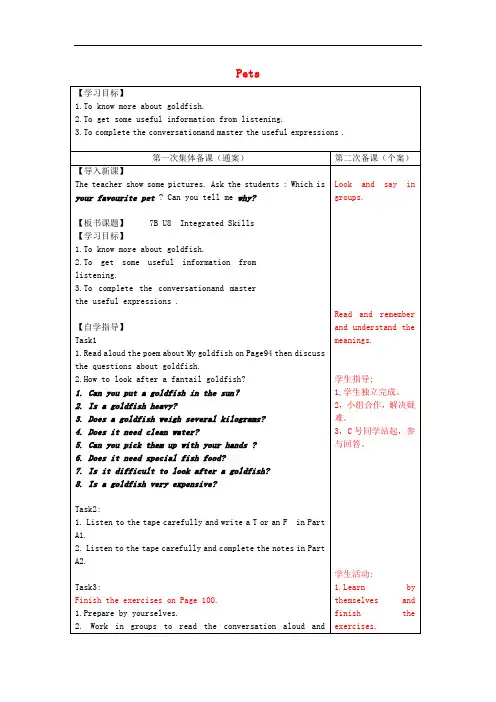
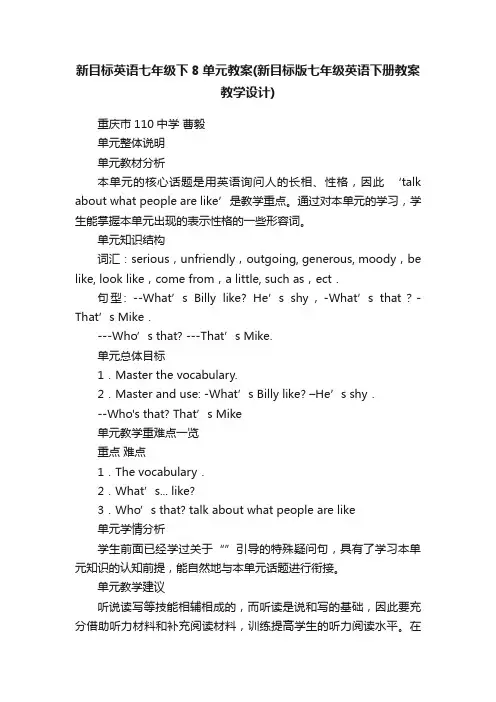
新目标英语七年级下8单元教案(新目标版七年级英语下册教案教学设计)重庆市110中学曹毅单元整体说明单元教材分析本单元的核心话题是用英语询问人的长相、性格,因此‘talk about what people are like’是教学重点。
通过对本单元的学习,学生能掌握本单元出现的表示性格的一些形容词。
单元知识结构词汇:serious,unfriendly,outgoing, generous, moody,be like, look like,come from,a little, such as,ect.句型: --What’s Billy like? He’s shy,-What’s that?-That’s Mike.---Who’s that? ---That’s Mike.单元总体目标1.Master the vocabulary.2.Master and use: -What’s Billy like? –He’s shy.--Wh o's that? That’s Mike单元教学重难点一览重点难点1.The vocabulary.2.What’s... like?3.Who’s that? talk about what people are like单元学情分析学生前面已经学过关于“”引导的特殊疑问句,具有了学习本单元知识的认知前提,能自然地与本单元话题进行衔接。
单元教学建议听说读写等技能相辅相成的,而听读是说和写的基础,因此要充分借助听力材料和补充阅读材料,训练提高学生的听力阅读水平。
在听读的基础上创设语言情景,加强说写能力的训练。
单元课时分配本单元共4课时:Section A(一)1课时Section A(二)1课时Section B(一)1课时Section B(二)1课时Section A(一)教学内容Section A中la. 1b.lc.2a.2b.2c Grammar focus教学目标知识与能力1、Match the vocabulary: serious,unfriendly, relationship, personality.2、Master and use:--What’s Billy like? --He's shy.--Who's that? --That’s Mike.过程与方法学生在前面已经学过了询问外貌特征的特殊疑问句,已具备了学习本课的初步知识。
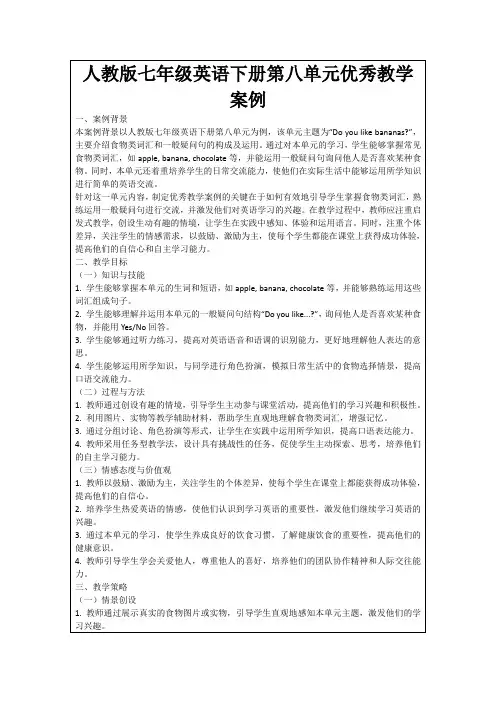
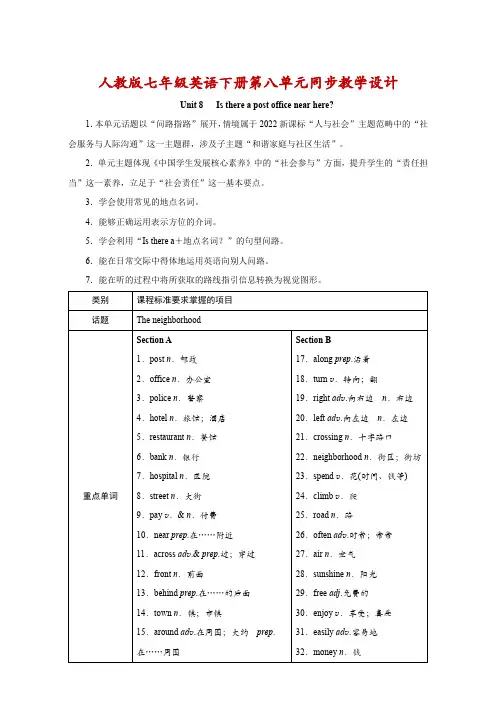
人教版七年级英语下册第八单元同步教学设计Unit 8Is there a post office near here?1.本单元话题以“问路指路”展开,情境属于2022新课标“人与社会”主题范畴中的“社会服务与人际沟通”这一主题群,涉及子主题“和谐家庭与社区生活”。
2.单元主题体现《中国学生发展核心素养》中的“社会参与”方面,提升学生的“责任担当”这一素养,立足于“社会责任”这一基本要点。
3.学会使用常见的地点名词。
4.能够正确运用表示方位的介词。
5.学会利用“Is there a+地点名词?”的句型问路。
6.能在日常交际中得体地运用英语向别人问路。
7.能在听的过程中将所获取的路线指引信息转换为视觉图形。
续表【课时建议】本单元建议5课时Section A (1a-1c)(一课时)Section A (2a-2d)(一课时)Section A (Grammar Focus-3c)(一课时)Section B (1a-1d)(一课时)Section B (2a-Self Check)(一课时)词汇短语:主要采用图片及多媒体展示助记法。
基本句子:采用多媒体展示及交际法(利用多媒体展示两人进行交际时的情景)。
语法:学会问路与指路。
第一课时Section A (1a-1c)Step 1情景导入【参考案例】(Show a picture of a neighborhood.)Teacher:Where is the…in the picture?Students:It is…设计意图:结合街道图,教授一些常见的表示方位的单词和词组,激发学生说英语的热情,活跃课堂气氛,轻松自如地导入单元话题,让学生更好地理解和掌握表示方位的单词和词组。
Step 2完成教材1a-1c的任务【操作案例】1.认真观察1a图片,完成1a的任务。
2.认真听录音,完成1b的任务。
3.大声朗读并背诵1b中的对话,结对练习1b中的三个小对话,请最熟练的一组到讲台上展示。
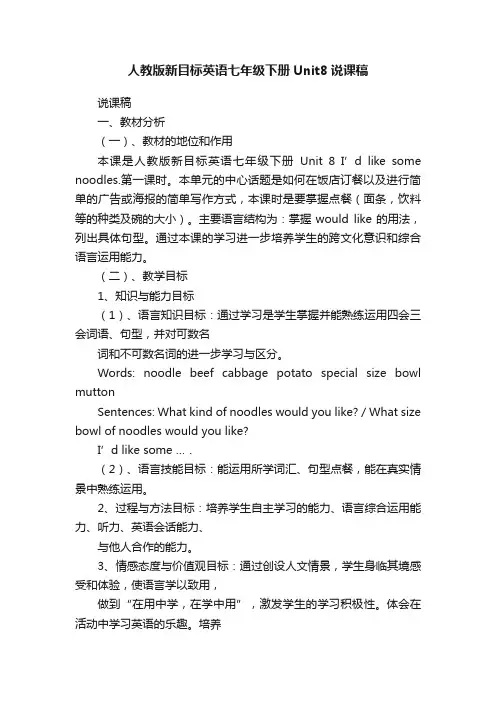
人教版新目标英语七年级下册Unit8说课稿说课稿一、教材分析(一)、教材的地位和作用本课是人教版新目标英语七年级下册Unit 8 I’d like some noodles.第一课时。
本单元的中心话题是如何在饭店订餐以及进行简单的广告或海报的简单写作方式,本课时是要掌握点餐(面条,饮料等的种类及碗的大小)。
主要语言结构为:掌握would like的用法,列出具体句型。
通过本课的学习进一步培养学生的跨文化意识和综合语言运用能力。
(二)、教学目标1、知识与能力目标(1)、语言知识目标:通过学习是学生掌握并能熟练运用四会三会词语、句型,并对可数名词和不可数名词的进一步学习与区分。
Words: noodle beef cabbage potato special size bowl muttonSentences: What kind of noodles would you like? / What size bowl of noodles would you like?I’d like some ….(2)、语言技能目标:能运用所学词汇、句型点餐,能在真实情景中熟练运用。
2、过程与方法目标:培养学生自主学习的能力、语言综合运用能力、听力、英语会话能力、与他人合作的能力。
3、情感态度与价值观目标:通过创设人文情景,学生身临其境感受和体验,使语言学以致用,做到“在用中学,在学中用”,激发学生的学习积极性。
体会在活动中学习英语的乐趣。
培养学生乐于与他人合作的精神及养成科学的饮食习惯。
4、文化意识目标:通过对中、西方在饮食及用餐方面异同的对比,对祖国饮食文化能有更深刻的了解。
乐于了解异国文化,加强对文化差异的理解与认识。
5、学习策略目标:通过学习,是学生在一定程度上形成自主学习、探究学习、合作学习的习惯,有效交际、用英语思维的能力。
(三)、教学重点与难点重点:1、学习日常生活中有关食物的名称。
2、进一步学习与区分可数名词与不可数名词。
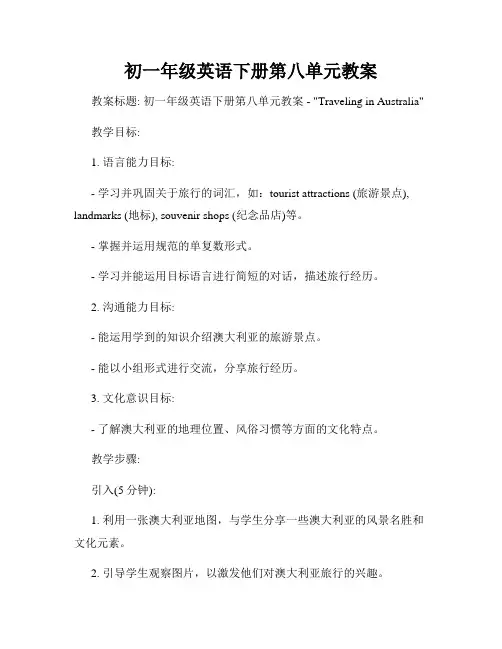
初一年级英语下册第八单元教案教案标题: 初一年级英语下册第八单元教案 - "Traveling in Australia"教学目标:1. 语言能力目标:- 学习并巩固关于旅行的词汇,如:tourist attractions (旅游景点), landmarks (地标), souvenir shops (纪念品店)等。
- 掌握并运用规范的单复数形式。
- 学习并能运用目标语言进行简短的对话,描述旅行经历。
2. 沟通能力目标:- 能运用学到的知识介绍澳大利亚的旅游景点。
- 能以小组形式进行交流,分享旅行经历。
3. 文化意识目标:- 了解澳大利亚的地理位置、风俗习惯等方面的文化特点。
教学步骤:引入(5分钟):1. 利用一张澳大利亚地图,与学生分享一些澳大利亚的风景名胜和文化元素。
2. 引导学生观察图片,以激发他们对澳大利亚旅行的兴趣。
呈现和练习(25分钟):1. 与学生一起复习和学习有关旅行的单词和短语,如:tourist attractions (旅游景点), landmarks (地标), souvenir shops (纪念品店)等。
老师可通过投影或者教材呈现相关图片和词语,并引导学生正确读音和单词意义。
2. 运用多媒体资源或图片展示澳大利亚著名的旅游景点,并介绍一些相关的信息,如:Great Barrier Reef, Sydney Opera House等。
学生可边听边记录。
3. 将学生分成小组,要求他们在小组内展示他们刚才了解到的景点,并准备一段简短的对话,描述他们在那些景点的旅行经历。
总结(10分钟):1. 回顾学习的关键词汇和短语,并帮助学生巩固记忆。
2. 小组交流:鼓励学生互相分享他们展示的景点和旅行经历,以提高他们的沟通能力。
作业(5分钟):1. 要求学生准备一份简单的澳大利亚旅行日记,描述他们想去或者已经去过的澳大利亚旅游景点。
他们可以选择绘画、写作或者使用其他创意方式来完成。
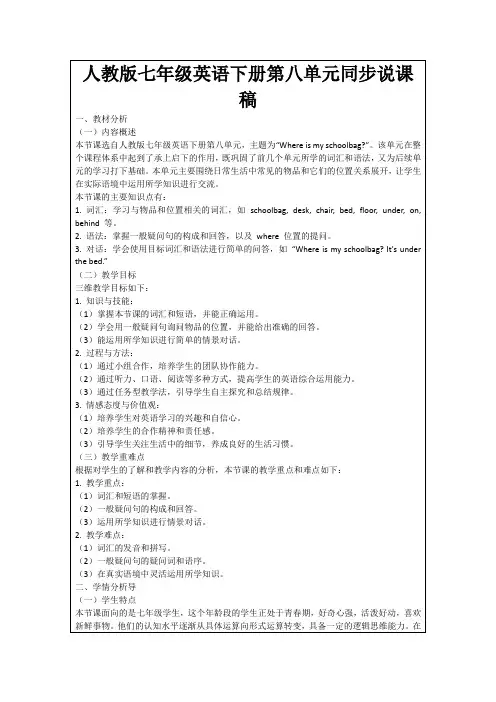
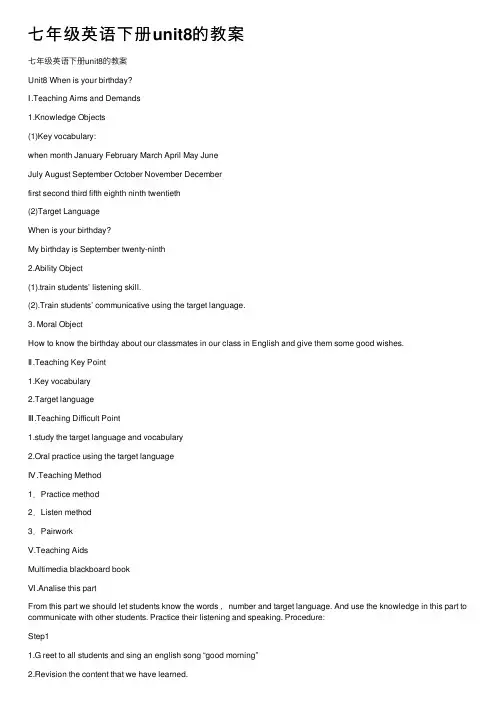
七年级英语下册unit8的教案七年级英语下册unit8的教案Unit8 When is your birthday?Ⅰ.Teaching Aims and Demands1.Knowledge Objects(1)Key vocabulary:when month January February March April May JuneJuly August September October November Decemberfirst second third fifth eighth ninth twentieth(2)Target LanguageWhen is your birthday?My birthday is September twenty-ninth2.Ability Object(1).train students’ listening skill.(2).Train students’ communicative using the target language.3. Moral ObjectHow to know the birthday about our classmates in our class in English and give them some good wishes.Ⅱ.Teaching Key Point1.Key vocabulary2.Target languageⅢ.Teaching Difficult Point1.study the target language and vocabulary2.Oral practice using the target languageⅣ.Teaching Method1.Practice method2.Listen method3.PairworkⅤ.Teaching AidsMultimedia blackboard bookⅥ.Analise this partFrom this part we should let students know the words ,number and target language. And use the knowledge in this part to communicate with other students. Practice their listening and speaking. Procedure:Step11.G reet to all students and sing an english song “good morning”2.Revision the content that we have learned.Eg: what’s this in English?What colour is this?Do you have a computer in your home?How much…………?Etc.Step2Today let’s study a new unit “Unit 8 when is your birthday?”First study some words:1.Let students look at the picture and read the words, the teacher can correct how to pronounce2. The teacher teaches them to read the words together3. practice 1: The teacher speaks chinese and let students speak in English, and then change4.Practice how to read these months in English( use thepictures on the screen, ask students which month he sees.)5.Let’s look at 1a listen and repeatStep3Study the number : 1. Revision the number(1).Read the number together .(2).Do a chant.2.Teach students the method how tochange these number.Step4Practice :1.Match the festivals (节⽇)with the dates.1. Tea chers’ Day(教师节)March 8th2.Women’s Day(妇⼥节) May 1st3.Children’s Day(⼉童节) June 1st/doc/6c11137446.htmlbor Day(劳动节)December 25th5.New Year’s Day(元旦)January 1st6.New Year’s Day(元旦)September 10th2.Can you say the dates(说说⽇期):1. 2⽉14⽇2. 3⽉8⽇3. 4⽉21⽇4. 1⽉29⽇5. 8⽉12⽇6. 9⽉10⽇7. 10⽉1⽇8. 12⽉25⽇9. 6⽉15⽇Step51.Look at our English: Activity 1b listen and number the conversation 1--3 .(1).The first time we just listen and understand themeaning.(2).The second time write the answer.2. Look at 1c pairworkA. When is your birthday?B. My birthday is -----------(1). Practice making conversation like 1c.(2).Look at the pictures to practice our spoken English. Step6Have a birthday part for a student.Step7 SummarySay ,in this class we’ve learn some words about month and how to express--------. We must know how to use knowledge to practice target language and conversation with our classmates.Step8 HomeworkMake a survey: When is your birthday?Fill in the form, then write a report.Report: My name is________. My birthday is _____. My friend A `s birthday is______. B’s birthday is ___。
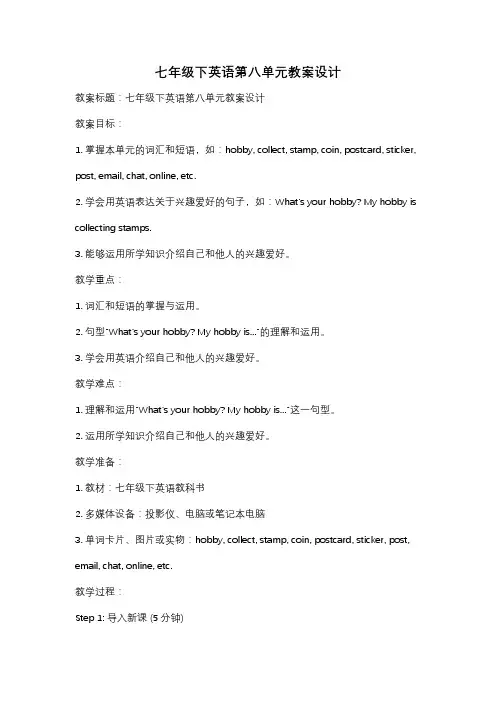
七年级下英语第八单元教案设计教案标题:七年级下英语第八单元教案设计教案目标:1. 掌握本单元的词汇和短语,如:hobby, collect, stamp, coin, postcard, sticker, post, email, chat, online, etc.2. 学会用英语表达关于兴趣爱好的句子,如:What's your hobby? My hobby is collecting stamps.3. 能够运用所学知识介绍自己和他人的兴趣爱好。
教学重点:1. 词汇和短语的掌握与运用。
2. 句型"What's your hobby? My hobby is..."的理解和运用。
3. 学会用英语介绍自己和他人的兴趣爱好。
教学难点:1. 理解和运用"What's your hobby? My hobby is..."这一句型。
2. 运用所学知识介绍自己和他人的兴趣爱好。
教学准备:1. 教材:七年级下英语教科书2. 多媒体设备:投影仪、电脑或笔记本电脑3. 单词卡片、图片或实物:hobby, collect, stamp, coin, postcard, sticker, post, email, chat, online, etc.教学过程:Step 1: 导入新课 (5分钟)1. 通过展示或出示图片、实物等引起学生对兴趣爱好的兴趣,如:stamps, coins, postcards等。
2. 引导学生用中文回答问题"What's your hobby?",并引导他们思考如何用英语回答。
Step 2: 新词汇学习 (10分钟)1. 出示单词卡片或图片,教授新词汇并帮助学生正确发音和理解词义。
2. 进行词汇练习,如:师生对话、单词拼写、单词接龙等。
Step 3: 句型学习 (15分钟)1. 出示"What's your hobby? My hobby is..."的句型,并解释其用法和意义。

7BUnit8英语集体备课教案南沈灶中学7BUnit8英语集体备课教案主备人:马小红南沈灶中学7BUnit8英语集体备课教案主备人:马小红南沈灶中学7BUnit8英语集体备课教案主备人:马小红用法举例:1. Someone _______ (want) to see you at the school gate.2. There _______ (be) nothing wrong with the car.3. Mother will buy me _________ ______ (好吃的东西)this afternoon.4. How is __________ (一切)going?5. She eats nothing in the morning.= She ______ ______ ________ in the morning.Step 6 Exercises一、用所给词的适当形式填空。
1. There is not _________ (something) in the box.2. I’m glad to see that __________ (somebody) is here today.3. _________ (anything) is difficult if you put your heart into it.4. People in the shop are _________ (friend) to us.5. My dog is the __________ (clever) animal of all.二、翻译。
1. Hobo叫Eddie不要对他不礼貌。
Hobo asks Eddie not to ____________ to him.2. 我的狗是我的一位特殊朋友。
My dog is a ______________________.3. 金鱼很容易照看。
Unit 8 The Seasons and the WeatherTopic 1 What’s the weather like in spring?Section ASection A needs 1 period. Section A 需用1课时。
The main activities are 1a and 3a. 本课重点活动是1a和3a。
Ⅰ. Aims and demands目标要求1. (1)Learn the new words about seasons:spring, summer, fall, winter(2)Learn other new words:weather, warm, season, hot, cold, rain, snow, ground2. Learn how to describe the weather.What’s the weather like in spring? It’s warm.How is the weather in fall? It’s cool.When it snows, the ground is all white and I can make snowmen.3. Learn to use superlative forms to express preference about seasons.Which season do you like best, spring, summer, fall or winter?I liked winter before, but now I like summer best.Ⅱ. Teaching aids 教具图片/小黑板/录音机Ⅲ. Five-finger Teaching Plan 五指教学方案Step 1 Review 第一步复习(时间:5分钟)复习上单元内容,导入本课。
Unit 8 Review【复习目标】1.掌握并准确运用本单元重点单词、短语词组及句型。
2.熟记谈论计划和表示祝愿的用语。
【复习重点】:复习本单元重点词汇和重点句型。
【复习难点】:be going to与will的区别【教学程序】(一)师友互查以下词汇和短语1.exam(同义)2.take(过去式)3.have(过去式)4. without(反)4.Canada (形容词)5 .care(形)6.1eave(过去式)8.lucky(副)8.careful(副词)9.watch(单三)]0.west(形)] l.wish(单三)二.短语:(短语大PK)1 .take an exam 2.take care of=look after 3.move away 4.1eave...alone =leavc: sb. by oneself 5.walk the dog 6.play against7.take...out8.root forat noon 10.play basketbal1/tennis/volleybal 1 11 .have a party 12.keep doing sth 13. write down 14. be over 15.share ...with 16.take lessons(二)师友互相探讨句法结构和本单元语法l.be sure to do sth 可以和 be sure that 转换Eg: He's sure to come back.=I' m sure that he will come back.2.look forward to doing sth期盼着做某事(to为介词,后跟动名词作宾语)Eg:r m looking forward to working with you again.3.take care of=iook afterEg:Mary is looking after the old man. = Mary is taking care of the old man..4.too**40 太…而不能Eg: The boy is too young to go to school.5.take sb/sth to+地点“把某人/某物带到某地”。
教材来源:初中七年级《英语》教科书内容来源:七年级《英语(下册)》第八单元主题:Is there a post office near here?课时:共4课时.授课对象:七年级学生设计者:于卫平/巩义市直第二初级中学目标确定的依据1.课程标准相关要求课程标准三级目标要求七年级学生能听懂较慢语速、熟悉话题的简单对话;识别主题,获取主要信息;能引出话题并进行交谈,并能在口语活动中使用正确的语音语调。
2.教材分析本单元要求学生学会问路指路的表达,学会根据地图描述某个地点的具体位置。
Section A集中呈现了一些方位介词并通过问路的情景输入there be句型结构,训练学生运用该结构来练习如何问路指路。
该部分的难点是如何运用正确的方位介词来描述各种社区设施的地理位置。
Section B 是Section A的拓展延伸,话题上,拓展了问路指路的表达;在技能方面,进一步深化听说技能,加强读写训练。
难点是要让学生将指路信息串联起来,形成完整的描述,并以口头或笔头形式表达出来。
3.学情分析学生在小学阶段初步学习过there be句型的用法,这些为七年级顺利学习本单元奠定了知识基础。
本单元内容是第一次出现there be句型及相关的一些方位介词,学生应该能够熟练掌握there be句型的各种变换,但在运用时,学生可能会对指路中使用的常见词汇和表达用语出现错误,如:go along,turn left|right,on the |your left|right,at the first crossing等。
第一课时Section A 1a-2c【教学目标】1.通过课堂练习,能准确说出本节课所学9个地点名词6个方位介词。
2.通过小组活动,能熟练运用there be 句型及简单方位词。
3.通过听力练习,能听出听力材料中各个地点之间的位置关系并正确书写6个方位介词。
【评价任务】1.目标 1 通过看图片练习,Task1检查学生是否已掌握学习的9个地点名词。
人教版新目标七年级英语下册 Unit 8说课稿一. 教材分析人教版新目标七年级英语下册Unit 8的主要内容包括三个部分:Part A, Part B和Part C。
本节课的主题是关于一般现在时态的疑问句和回答。
通过本节课的学习,学生能够掌握一般现在时态的疑问句构成及其回答方式,并能运用所学知识进行实际交流。
二. 学情分析七年级的学生已经对人教版新目标英语有了初步的了解和认识,对于一般现在时态也有了一定的掌握。
但是,学生在实际运用中,尤其是在口语交流中,可能会存在一定的困难。
因此,在教学过程中,需要注重学生的实际操作和口语练习,提高他们的英语应用能力。
三. 说教学目标1.知识目标:学生能够掌握一般现在时态的疑问句构成及其回答方式。
2.能力目标:学生能够运用所学知识进行实际交流,提高英语口语表达能力。
3.情感目标:通过本节课的学习,学生能够激发对英语学习的兴趣,培养积极的学习态度。
四. 说教学重难点1.教学重点:一般现在时态的疑问句构成及其回答方式。
2.教学难点:学生在实际交流中正确运用一般现在时态的疑问句和回答。
五. 说教学方法与手段1.教学方法:采用任务型教学法,让学生在实际操作中掌握知识,提高能力。
2.教学手段:利用多媒体课件、图片等辅助教学,增加课堂趣味性,提高学生学习兴趣。
六. 说教学过程1.引入新课:通过展示图片,引导学生谈论图片中的人物和活动,引入一般现在时态的疑问句和回答。
2.讲解示范:讲解一般现在时态的疑问句构成及其回答方式,并进行示范。
3.实践练习:学生分组进行练习,用一般现在时态的疑问句提问并回答。
4.拓展延伸:引导学生运用所学知识进行情景对话,提高口语表达能力。
5.课堂小结:对本节课所学内容进行总结,加深学生对知识的理解。
七. 说板书设计板书设计主要包括一般现在时态的疑问句构成及其回答方式,以及相关例句。
通过板书,帮助学生梳理和巩固所学知识。
八. 说教学评价教学评价主要包括两个方面:过程性评价和终结性评价。